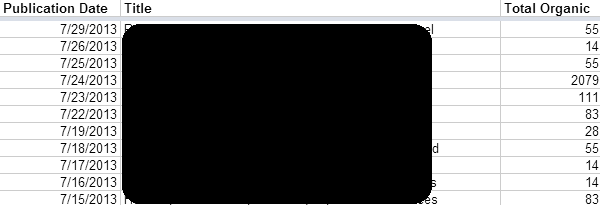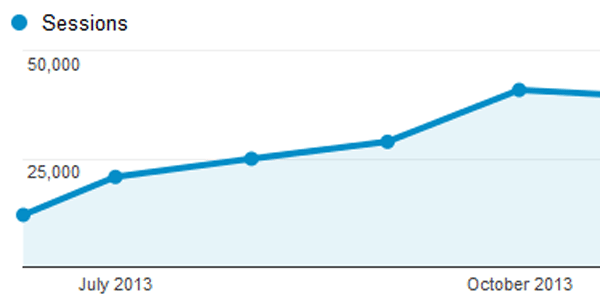3 Mindset Shifts: Get More SEO Out Of Your Content Marketing
Google is constantly working to provide users with a better experience, and marketers are constantly trying to adapt to these changes. Content-based SEO creates a compelling blend of authentic content and search engine eye-candy, but it also necessitates mastering both worlds (content marketing and SEO) instead of trying to rely on just one. And Google […]
Google is constantly working to provide users with a better experience, and marketers are constantly trying to adapt to these changes. Content-based SEO creates a compelling blend of authentic content and search engine eye-candy, but it also necessitates mastering both worlds (content marketing and SEO) instead of trying to rely on just one.
And Google is continuing to push the SEO community in that direction. Content marketing has been gaining acceptance as an SEO practice ever since Panda was rolled out — and with the release of Hummingbird, some content marketers have now become better at SEO than the long-time SEO practitioners that haven’t stayed ahead of these changes.
Whether you call yourself an SEO, a content marketer, or something in between, here are three key paradigm shifts you will need to understand in order get the most SEO out of your content.
Keywords & User Intent: Content For Every Combo
Keywords have always been an essential element of an effective SEO strategy, but their role is evolving. Yesterday’s SEO strategy would order a piece of high quality content for every keyword you’re working with. Today, keywords aren’t enough anymore; or rather, keywords aren’t the whole picture.
Take, for example, the top four results from a Google search for [content marketing strategy] (as depersonalized as I could manage):
How in the world can Google justify giving its top four spots to the same website?
Obviously, authority and popularity are factors. The Content Marketing Institute is the fastest growing B2B media company and is a well-known, respected authority on content marketing. But it’s rare to see 2 results from the same domain on page 1, let alone positions #1, #2, #3 and #4. Something else must be going on here — and that something is user intent.
Look closely:
- The first result is about developing a detailed strategy.
- The second gives a basic definition.
- The third provides a simple framework.
- The fourth promises a source of updated, new information.
A user looking for detailed instructions will want the first link, while someone just starting out might prefer the third result. If someone is just looking for a basic definition he will click on the second result, while a user who needs a recently updated resource may be looking for the fourth one. Google provides all four, because all four are trusted and popular, and because they all speak to a unique user intent.
How do you determine the different user intents of a single keyword? Google it! Then examine the SERPs and think through why the algorithm chose to display those specific links. The results represent Google’s best guess at the user’s intent for that search (and Google has a lot of data behind those “guesses”). Are there landing pages and resources on your website that mirror each one? Are there any user intents that are missing? Any unmet needs that you can fill?
Keyword percentages are so 2000s. Today, the cool kids are aligning content with keyword and user intent combinations.
Optimize For Intent: Targeted Blog Posts
SEO used to develop blog content strategies around keywords, and then optimize each post for those words and phrases. But when blogs are optimized for keywords alone, this kind of traffic happens:
Most of the posts on this popular blog drive no more than a handful of organic search visitors. But what happened on July 24?! We could filter through that post and try to duplicate every nuance, and never get the same result — because, from an SEO standpoint, that post probably just got lucky. It managed to hit that sweet spot where keyword optimization and user intent collide, and they really found their audience on search results. (And we’re pretty sure it was luck, because almost all of the posts on this blog failed to drive any noteworthy organic search traffic for many months.)
Now, here’s a look at the organic traffic to that same blog throughout the rest of the year as the authors began to focus on keywords and user intent.
Keyword optimization alone simply doesn’t cut it anymore. Google’s not looking for keywords — it’s looking for useful content that outperforms the competition. Crafting content to meet a specific user intent (and still meet the needs of your blog’s editorial calendar and social media strategies) does take more work, but blogs posts that attract organic traffic each and every day for months and even years to come are very much worth it.
The Future Of Content-Based SEO
Sound easy so far? Well, don’t get too comfortable. Even as marketers expand their content strategies to include combinations of keywords and user intent, Google is still segmenting — still perfecting their people modeling.
Google is uniquely positioned at the intersection of search and social (and more), which means the amount of user data at their fingertips is massive. Their understanding of user behavior is allowing their services to infer user interests — so even if they don’t have much data on you, but they know who your friends are, they can target content for you based on your friends’ interests.
In other words, Google is the epitome of Big Data, and that means Google’s search results will only become more fine-tuned and even more personalized.
What we know for certain right now is that the data giant is building “audiences” based on websites visited, user information provided to Google partners, and third-party data. These “audiences” are convenient for traditional marketers because they can easily choose to send ads to a very targeted group. Regarding SEO, it’s further evidence that Google is collecting and organizing user data from all over the web, and the content in search results will become more and more tailored to each unique IP address (far more than geo-localized personalization).
Designing SEO content for each combination of keyword and user intent is a great first step, but the day is coming when we will need to consider content for every keyword + user intent + audience/persona combination. That’s right, my friend: Google is only going to get smarter.
Everybody Wins, Probably
It may seem daunting. Most marketers aren’t necessarily cheering Google on in their conquest of the online world, because this amount of data – enough to create such advanced affinity and market segmentation – is enormous, frightening, and perhaps even monopolistic. The end result, though, is the potentially for everybody to win. Users get better search results, traditional marketers get better ad campaign results, and content marketers that develop smarter content strategies earn more traffic. But sorry guys, there are still no guarantees in the wild world of SEO.
Contributing authors are invited to create content for Search Engine Land and are chosen for their expertise and contribution to the search community. Our contributors work under the oversight of the editorial staff and contributions are checked for quality and relevance to our readers. The opinions they express are their own.
Related stories


